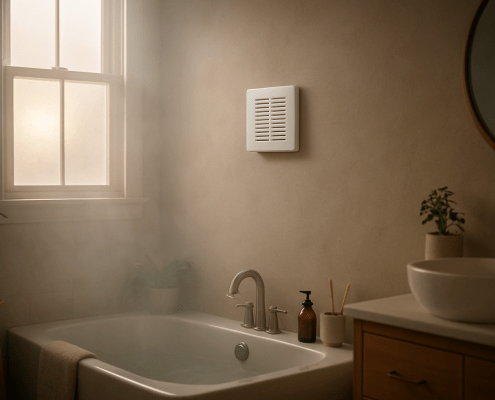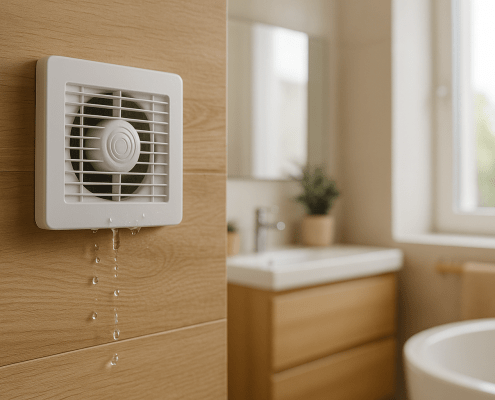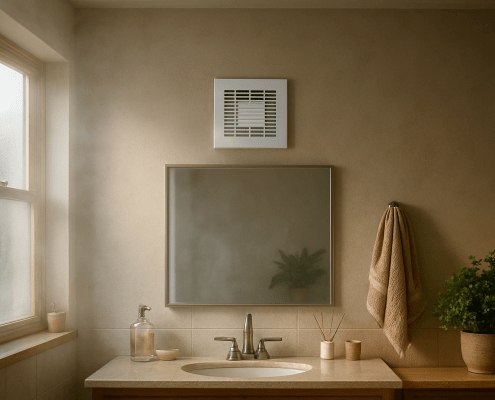How To Fix a Humidity Sensor Bathroom Fan That Doesn’t Shut Off
Steven E / Wednesday July 2, 2025
Humidity-sensing bathroom fans are a smart upgrade for keeping moisture levels under control. They automatically turn on when humidity rises, such as during or after a shower, and shut off once the air dries out. But what happens when that convenient automation becomes a headache? If your humidity sensor fan refuses to shut off, it can lead to wasted energy, unnecessary noise, and even shorten the fan’s lifespan.
Fortunately, issues that cause a bathroom fan to run continuously are easy to identify and fix. We’ll walk you through common causes, how to test your humidity sensor, and what steps you can take to get your fan working again.
The information in this article may not apply to your specific appliance model. We recommend consulting your manufacturer’s documentation or contact us with any questions.
How Humidity-Sensing Bathroom Fans Work
Before we dive into troubleshooting, it helps to understand how these fans are supposed to operate. Here’s the basic idea:
- A built-in humidity sensor monitors moisture levels in the bathroom.
- When humidity rises above a set threshold (often 60% or so), the fan turns on automatically.
- When humidity falls below that threshold, the fan shuts off.
- Most models also include a manual override switch so you can turn the fan on or off directly if needed.
These systems are designed for convenience, energy efficiency, and to reduce mold or mildew buildup. But if your fan stays on constantly, even when the room is dry, it’s time to look closer.
Common Reasons a Humidity Sensor Fan Won’t Shut Off
Several issues can cause your fan to run longer than it should. The most frequent causes include:
- Humidity levels never drop below the fan’s shutoff point.
- Dirty or obstructed humidity sensor.
- Incorrect fan settings or programming.
- Manual override left on.
- Faulty humidity sensor.
- Bad control board or wiring issue.
Let’s troubleshoot these one at a time.
Step 1: Let the Bathroom Fully Dry Out
It may sound obvious, but the first thing to rule out is whether the bathroom is still humid.
- Leave the fan running with the door open for at least 30–60 minutes.
- Avoid using hot water or creating new steam during this time.
- Use a portable hygrometer to monitor humidity levels in the room.
- If humidity falls below 50%–60% and the fan still runs, then it’s likely a fan or sensor issue, not the environment.
Keep in mind that high outdoor humidity, poor ventilation, or even drying laundry indoors can slow down how quickly a room dehumidifies.
Step 2: Clean the Humidity Sensor
Humidity sensors are sensitive components. Over time, dust, lint, or grime can interfere with accurate readings and cause the fan to misbehave.
- Turn off the power to the fan at the circuit breaker.
- Remove the fan grille or cover.
- Locate the sensor (usually a small, plastic module attached to the housing or control board).
- Use a soft brush or compressed air to gently clean around the sensor.
- Wipe nearby surfaces with a microfiber cloth.
Avoid using any liquid cleaners or solvents, as they can damage the sensor.
Step 3: Check the Settings or DIP Switches
Many humidity-sensing fans include adjustable settings, either through DIP switches or control dials. These allow you to customize humidity thresholds, delay times, and manual override behavior.
- Refer to the fan’s user manual (you can usually find it online by model number).
- Turn off the power at the breaker before adjusting any internal switches.
- Use a small screwdriver to flip DIP switches or dial settings as recommended.
After adjusting, turn the power back on and test again.
Step 4: Make Sure the Manual Override Isn’t Active
If your fan has a wall switch, it may include a manual “on” mode that keeps the fan running continuously, regardless of humidity.
- Flip the switch off for 10–15 seconds.
- Then flip it back on and let the fan run.
- Monitor whether it turns off after a reasonable time once the room is dry.
If your fan includes an LED indicator, check whether it shows the fan is in automatic or manual mode.
Step 5: Test the Humidity Sensor
If cleaning and adjusting the settings doesn’t fix the problem, the humidity sensor itself might be faulty.
- Allow the bathroom to dry fully.
- Set the humidity threshold on the fan to the highest setting (e.g., 80%).
- Use a hygrometer to confirm the room is below that threshold.
- Wait to see if the fan shuts off within 10–20 minutes.
If it continues to run despite dry air and correct settings, the sensor is likely not functioning properly.
Step 6: Check the Wiring
Improper or damaged wiring can cause the fan to stay on indefinitely. If you or someone else installed the fan recently, double-check all connections.
- Turn off the power at the breaker.
- Remove the fan grille and access the wiring compartment.
- Use the wiring diagram provided by the manufacturer to confirm proper connection of hot, neutral, and ground wires and the connection to the humidity sensor module.
- Look for loose wire nuts, frayed wires, or signs of shorting.
If you’re comfortable with a multimeter, you can check for the correct voltage across the terminals. If wiring is incorrect or compromised, fix as needed.
Step 7: Replace the Humidity Sensor (If Applicable)
Some fan models allow you to replace just the humidity sensor instead of the entire fan.
- Look up the fan’s make and model number.
- Search for compatible replacement sensor modules, which are often sold as plug-in components.
- Remove the faulty sensor and replace it with the new one (usually attached with screws or clips and a simple connector).
This fix is often quicker and cheaper than replacing the whole fan, especially if the motor and housing are in good condition.
Step 8: Replace the Entire Fan (If Necessary)
If the sensor is non-replaceable or the fan is older, it might make more sense to replace the entire unit.
When to Replace:
- The humidity sensor is hardwired and not serviceable.
- The fan motor is noisy, sluggish, or constantly running.
- You want a quieter or more energy-efficient model.
Choose a model with clearly labeled controls and replaceable sensors for easier future maintenance.
Bonus Tip: Upgrade to a Smart Switch or Humidity Sensor
If your fan isn’t equipped with a built-in sensor or you want more control, consider installing a humidity-sensing wall switch instead. These retrofit easily and allow you to control almost any standard bathroom fan. This upgrade gives you similar functionality without replacing the fan itself.
Where To Find Us
If you need any replacement parts for your appliances, you can enter your model number at AppliancePartsPros.com to locate and order them quickly. Most orders arrive in just two business days, and we have tons of great information in our repair help section and YouTube videos to help you troubleshoot.
Stay connected with the latest DIY tips, tutorial videos, and repair guides by following us on Facebook, Instagram, and Twitter. We love hearing about your repair stories and successes. If you need more help or want personalized guidance, feel free to reach out. We’re ready to help you take on your next project with confidence!
With nearly a decade of experience in providing top-notch customer service regarding appliance parts and repair, Steven enjoys sharing practical advice, troubleshooting tips, and interesting information to help readers stay informed.





